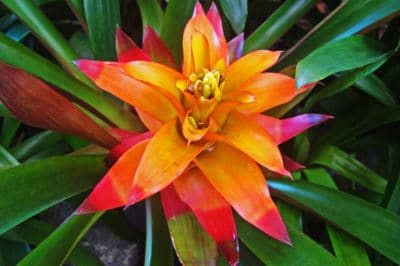Varieties of Guzmania Lingulata
New varieties of this bromeliad appear all the time. These are some that are currently available:
- Scarlet Star – one of the most common; the name describes the plant.
- Orange Star – bright orange bracts.
- Luna – an unusual variety with mauve bracts.
- Rana – newer hybrid; the orange-red flower spike is larger than the species.
Light Matters – A Lot
If there is a single factor that weighs more heavily than others in caring for bromeliads, it is light. These tropical and semi-tropical plants are used to 10 or 12 hours of bright indirect sunlight each day. In your home, you can usually find similar conditions in an east- or west-facing window. In winter, a southern exposure is better. All should have translucent shades to protect against direct sunlight.
The Right Soil
Guzmania lingulata is a epiphytic bromeliad variety, which means it gets little nourishment and water through its roots. It needs excellent drainage, so commercial orchid or bromeliad mix is a good choice. Don’t use regular potting soil; it drains too slowly. Mix your own with equal parts perlite, fir bark or coconut coir and sphagnum peat moss. Fertilize with dilute water-soluble fertilizer during the growing season.
Watering Guzmania Lingulata
Like many bromeliads, Guzmania lingulata should be well watered infrequently and then allowed to dry out until the top two inches of soil is dry. It’s better to use room temperature tap water, filtered water or distilled water to prevent salt build-up. Softened water and tap water are high in salts and chemicals such as chlorine. Use glass or plastic water containers – bromeliads are sensitive to metals.
Humidity and Temperature
Temperature and humidity interact in your bromeliad’s environment. With higher humidity, these plants can tolerate higher temperatures. However, the normal environment indoors tends to be dry, especially in winter with central heating. Mist plants twice a day and group together. Place potted plants on shallow trays filled with pebbles and water to increase humidity.
Growing More
Guzmania lingulata reproduces by means of offsets called pups. After the plant flowers, it will eventually die, but in the meantime, it begins to grow offsets that are clones of the mother plant. These can be detached and potted to grow replacement plants. You’ll usually be most successful if you wait to repot until the pup has grown its own set of roots.
